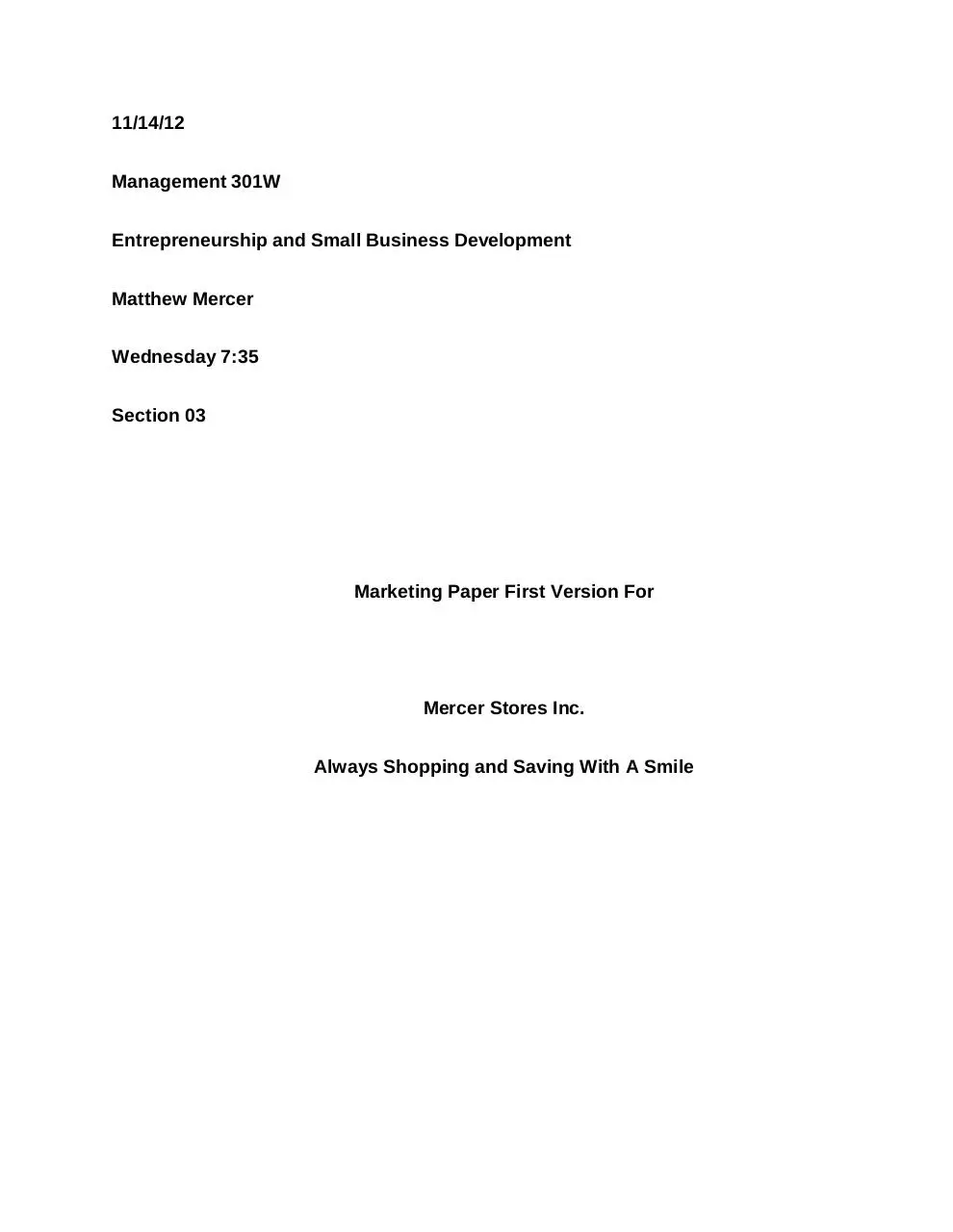Mercer Stores Marketing (PDF)
File information
Author: racin
This PDF 1.5 document has been generated by Microsoft® Word 2016, and has been sent on pdf-archive.com on 13/02/2017 at 03:11, from IP address 73.69.x.x.
The current document download page has been viewed 357 times.
File size: 420.09 KB (11 pages).
Privacy: public file





File preview
11/14/12
Management 301W
Entrepreneurship and Small Business Development
Matthew Mercer
Wednesday 7:35
Section 03
Marketing Paper First Version For
Mercer Stores Inc.
Always Shopping and Saving With A Smile
Contents
Introduction ..................................................................................................................... 2
Products and Services .................................................................................................... 2
Pricing Strategy ............................................................................................................... 3
Funding ........................................................................................................................... 5
Assets ............................................................................................................................. 7
Income Statements ......................................................................................................... 7
Bibliography .................................................................................................................. 10
Introduction
My name is Matthew Mercer and this is my business, Mercer Stores Inc. The purpose of
this paper is to explain my marketing plan, and give projections of business
performance as soon as it opens. I hope this gains your attention and approval of my
business and its plan.
Products and Services
The products that will be offered within my company (or store) are clothing apparel for
men, women, kids and infants as well. Clothing for men will range from short & long
sleeve t-shirts, to sweaters. Men’s dress shirts will also be sold but are folded and
wrapped in plastic. Variety of pants will be in stock as well, ranging from jeans, exercise
pants, shorts for summer, and etc. Jackets and hoodies for both genders will be offered,
along with kids and even infant sizes as well. Women’s clothing will include tank tops,
blouses, sweaters and whatever else is in women’s fashion. Same thing goes for
women’s pants, ranging from skirts, dresses and work pants. Kids clothing will be much
like their adult counter parts, except in children’s sizes. Of course the kids clothing will
be more appropriate for their age. Infant clothing will be sold according to infant sizing
and what’s appropriate for them. Shoes will be sold as well, but in small amounts, all
focusing towards women. Any non-clothing associated products are offered are located
in front of the store by the cashiers. A refrigerator with bottles of soda will be for sale.
Along with small amounts of chocolate, candy and mixed snack products available for
purchase right at the register.
Services include reliable cashiers who will run the transactions for customer purchases,
handle exchanges of items and returns if a receipt is provided, within 30 days of the
purchase. Customer service will be provided as well, answer any question the customer
has to ask. Point them in the right direction and help find the product they’re looking for.
Pricing Strategy
Odd pricing is psychological pricing strategy in which goods are priced at for example,
$19.99, rather than $20.00. This makes it look like that it’s much lower than it really is,
compared to the other price. (Hatten) This displays the illusion that it’s cheaper, which in
turn can gather a lot of sales and positive response from customers. The disadvantage
to this is some customers may see through the method, and it won’t influence their
decision on purchasing the item. The pricing may also devalue a high quality product,
making it look less valuable or less quality. (Clark)
Markup or Cost-Plus pricing involves the adding of a fixed percentage or fee to the
cost of the item. (Hatten) If an item cost $10.00, and the selling price is $11.00, the
mark up is $1.00 or about 10%. The advantages of this kind of pricing are the flexibility
of it. Especially in situations when total costs are unclear at the start of production, sale
or even before any of that occurs. This allows for additional equipment and materials to
be purchased in order to complete the job. Transparency also is an advantage; this
allows buyers to easily ensure they are paying only for the costs incurred and also
makes it difficult for sellers to inject hidden fees. (Beach) This form of pricing is also
easy to administer. It shows up on invoices and paperwork and is easier to calculate.
Basically it’s easier to document. However, there are disadvantages of course,
efficiency is affected by the fact that, if costs of production were to decrease, then
pricing should decrease as well. This will then decrease any incentive to find faster
cheaper and effective ways of producing products. This in turn can cause a loss of
market share due to competitors finding faster ways of producing product faster.
Another disadvantage is customer value, since it all boils down to how much the
consumer will pay for the product. It ignores demand and the position of the market, and
ignores the role of customers. Missed profit opportunities may occur, since this is
throwing extra cost to the customer, and may steer them away from buying the product.
(Williams)
Price lining involves grouping product prices into ranges, such as low, medium, and
high priced items. This in turn involves quality of the items, for example, if a line of shirts
are lower quality materials, they can be placed in the $10 range, whereas shirts with a
medium quality in $20 range, and high quality in the $30 range. An advantage of this
method is that it gives customers the flexibility of choice, like if they want something of
higher quality they can go into the higher price brackets. This also makes it easier to
focus a single brand, which can lower advertising costs and etc. This also can reduce
inventory, which in turn reducing inventory carrying costs. Disadvantages of this method
include a narrow focus on cost alone. From a business point of view, the company won’t
take inflation or customer purchasing trends into account with making the prices. If the
economy goes downhill or customer trends shift towards the lower cost inventory, the
company is stuck with higher priced inventory to sell, which increases inventory carry
costs. Plus the differentiation of benefits between lower and higher end items could be
of little or no difference to the customer, which may turn the customer away from buying
any of the range of that product. (Nation)
I plan on using the markup or cost-plus pricing for my company’s pricing model or
strategy. However, I will use the other price strategies I mentioned and blend them
together. The cost plus pricing is easier to utilize and in turn generates extra cash or
profit, while at the same time won’t be expensive to the consumers. It’s also not difficult
to have to calculate when I have to adjust or change prices. I will mix the odd pricing
structure, of making an item for example, 1 cent lower of the whole dollar, like a bottle of
soda will be 99 cents instead of $1.00. It appears more reasonable and better looking to
buy to the customer, because they feel they’re saving money. The price lining will only
be used with there’s different lines of quality for a product or brand that is being sold in
the store. For Polo brand shirts for example, highest quality shirts will be placed in the
high range, let’s just say $50 range. Average quality or above average quality could sit
around $35 range, and lower quality will be in lower $20 range. These numbers are
merely examples but this is just a good idea of how price lining will be used.
Funding
504 Loan Program is an economic development loan program that offers small
businesses another financing option for fixed costs, assist in promoting job creation and
business growth. (CDC/504 Loan Program) Fixed costs include but are not limited to,
utilities and rent. This loan also covers equipment, such as machinery, registers,
appliances for the maintaining the building, like air conditioning or heat. This loan could
also be used to refinance debt connected with expanding the business. It can also be
used to purchase an existing building, make utility improvements such as parking lot,
lighting, landscaping and etc. Purchasing long term machinery is allowed under this
type of loan as well.
7(a) Loan is a loan specified to help businesses with special requirements. Such as
businesses that export to foreign countries, businesses that operate in rural areas and
other specific purposes. (7 (a) Loan Program) Special purpose program includes
companies that focus on pollution control and environmental concerns. This can be
used for long-term or short-term working capital, such as paying accounts payable,
purchase of inventory and construction financing. Maximum loan size is $350,000.
Microloan program is a small short-term loan to small businesses and certain types of
not-for-profit child-care centers. (Microloan Program) The maximum loan amount is
$50,000 however on average it goes for around $13,000. This type of loan maybe used
for working capital, purchase of inventory, supplies, equipment and furniture. The term
for this loan is 6 years.
I am choosing $50,000 from a microloan program, and $25,000 from 7(a) Loan. Then I
shall borrow $25,000 from friends and relatives, and investors will provide $50,000. This
brings my budget to $150,000 to start my business and I am leasing in Connecticut. I
chose from microloan program because it suits my business’ needs financially, and I fall
within those requirements in order to qualify for the loan such as purchasing inventory
equipment, and necessary work equipment. 7(a) loan because it’ll help me purchase
inventory as well. I planned on enlisting investors because they in turn will profit from
my business’ success, especially since they’ll have shares to own. Friends and relatives
will in turn gain shares and be reimbursed for their generous support.
Assets
Assets of Mercer Stores Inc
As of October 2012
Assets:
Cash
Inventory
Prepaid Expenses
Equipment
Property
Total Assets
$
28,000
100000
2000
11000
9000
150,000
$
Income Statements
Income Statement Mercer Stores Inc
For the month ended October 31 2012
Revenues:
$
210,000
70000
Sales
Cost of Goods Sold
Expenses:
Administrative
Advertising
Hourly
Insurance
Materials
Rent
Shipping
Telephone
$
9,500
7500
8272
1000
11000
6500
1100
250
Utilities
1500
State Income Tax
$
46,622
$
93,378
$
8,404
Net Income
$
84,974
Total Expenses
Income before
Taxes
Income Statement Mercer Stores Inc
For the month ended November 30 2012
Revenues:
$
198,750
69000
Sales
Cost of Goods Sold
Expenses:
Administrative
Advertising
Hourly
Insurance
Materials
Rent
Shipping
Telephone
Utilities
$
9,500
7500
8002
1000
750
6500
1100
250
1500
State Income Tax
$
36,102
$
93,648
$
8,428
Net Income
$
85,220
Total Expenses
Income before
Taxes
Download Mercer Stores Marketing
Mercer Stores Marketing.pdf (PDF, 420.09 KB)
Download PDF
Share this file on social networks
Link to this page
Permanent link
Use the permanent link to the download page to share your document on Facebook, Twitter, LinkedIn, or directly with a contact by e-Mail, Messenger, Whatsapp, Line..
Short link
Use the short link to share your document on Twitter or by text message (SMS)
HTML Code
Copy the following HTML code to share your document on a Website or Blog
QR Code to this page

This file has been shared publicly by a user of PDF Archive.
Document ID: 0000553571.